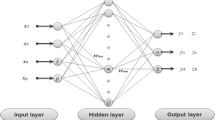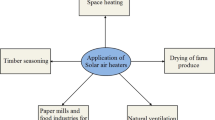Abstract
In the present study, artificial neural network (ANN) model has been developed with two different training algorithms to predict the thermal efficiency of wire rib roughened solar air heater. Total 50 sets of data have been taken from experiments with three different types of absorber plate. The experimental data and calculated values of collector efficiency were used to develop ANN model. Scaled conjugate gradient (SCG) and Levenberg–Marquardt (LM) learning algorithms were used. It has been found that TRAINLM with 6 neurons and TRAINSCG with 7 neurons is optimal model on the basis of statistical error analysis. The performance of both the models have been compared with actual data and found that TRAINLM performs better than TRAINSCG. The value of coefficient of determination \((\hbox {R}^{2})\) for LM-6 is 0.99882 which gives the satisfactory performance. Learning algorithm with LM based proposed MLP ANN model seems more reliable for predicting performance of solar air heater.










Similar content being viewed by others
Abbreviations
- \(A_{C}\) :
-
Area of collector surface \((\hbox {m}^{2})\)
- ANN:
-
Artificial neural networks
- \(a_{i}\) :
-
Input data
- \(b_{j}\) :
-
Bias
- \(C_{p}\) :
-
Specific heat \((\hbox {J kg}^{-1}\hbox {K}^{-1})\)
- COV :
-
Coefficient of variance
- e :
-
Roughness height (mm)
- e / D :
-
Relative roughness height
- I :
-
Solar intensity \((\hbox {W m}^{-2})\)
- LM :
-
Levenberg–Marquardt
- m :
-
Mass flow rate of air \((\hbox {kg s}^{-1})\)
- MSE :
-
Mean square error
- MAE :
-
Mean absolute error
- MRE :
-
Mean relative error
- MLP :
-
Multi-layered perceptron
- P / e :
-
Relative roughness pitch
- \(Q_{c}\) :
-
Energy gained by collector (W)
- \(Q_{u}\) :
-
Energy gained by air (W)
- RMSE :
-
Root mean square error
- R :
-
Correlation coefficient
- \(R^{2}\) :
-
Coefficient of multiple determination
- SSE :
-
Sum square error
- SCG :
-
Scaled conjugate gradient
- T :
-
Temperature (\({^\circ }\)C)
- \(w_{ij}\) :
-
Weights
- \(X_{a}\) :
-
Actual value
- \(X_{b}\) :
-
Predicted value
- Y :
-
Experimental data
- \(\upeta _{th} \) :
-
Thermal efficiency of collector (%)
- a :
-
Ambient air
- fi :
-
Inlet air
- fo :
-
Outlet air
- fm :
-
Mean air
- min :
-
Minimum
- max :
-
Maximum
References
Duffie JA, Beckman WA (1991) Solar engineering of thermal processes, 2nd edn. Wiley Publication, New York
Garg HP, Prakash J (2000) Solar energy fundamentals and applications, 1st edn. Tata McGraw-Hill, New Delhi
Haykin S (1994) Neural networks: a comprehensive foundation. Prentice- Hall, New Jersey
Bhushan B, Singh R (2010) A review on methodology of artificial roughness used in duct of solar air heaters. Energy 35:202–212
Prasad BN (2013) Thermal performance of artificially roughened solar air heaters. Sol Energy 91:59–67
Prasad BN, Behura AK, Prasad L (2014) Fluid flow and heat transfer analysis for heat transfer enhancement in three sided artificially roughened solar air heater. Sol Energy 105:27–35
Sharma SK, Kalamkar VR (2015) Thermo-hydraulic performance analysis of solar air heaters having artificial roughness—a review. Renew Sustain Energy Rev 41:413–435
Patil AK (2015) Heat transfer mechanism and energy efficiency of artificially roughened solar air heaters—a review. Renew Sustain Energy Rev 42:681–689
Kalogirou SA (2000) Applications of artificial neural-networks for energy systems. Appl Energy 67(1–2):17–35
Yang IH, Yeo MS, Kim KW (2003) Application of artificial neural network to predict the optimal start time for heating system in building. Energy Convers Manag 44:2791–2809
Ertunc HM, Hosoz M (2006) Artificial neural network analysis of a refrigeration system with an evaporative condenser. Appl Therm Eng 26:627–635
Kalogirou SA (2006) Prediction of flat-plate collector performance parameters using artificial neural networks. Sol Energy 80:248–259
Sozen A, Menlik T, Unvar S (2008) Determination of efficiency of flat-plate solar collectors using neural network approach. Expert Syst Appl 35(4):1533–1539
Kurt H, Atik K, Ozkaymak M, Recebli Z (2008) Thermal performance parameters estimation of hot box type solar cooker by using artificial neural network. Int J Therm Sci 47:192–200
Caner M, Gedik E, Kecebas A (2011) Investigation on thermal performance calculation of two type solar air collectors using artificial neural network. Expert Syst Appl 38(3):1668–1674
Benli H (2013) Determination of thermal performance calculation of two different types solar air collectors with the use of artificial neural networks. Int J Heat Mass Transf 60:1–7
Ceylan I, Gedik E, Erkaymaz O, Gürel AE (2014) The Artificial neural network model to estimate the photovoltaic module efficiency for all regions of the Turkey. Energy Build 84:258–267
Esen H, Esen M, Ozsolak O (2017) Modelling and experimental performance analysis of solar-assisted ground source heat pump system. J Exp Theor Artif Intell 29(1):1–17. https://doi.org/10.1080/0952813X.2015.1056242
Jani DB, Mishra M, Sahoo PK (2016) Performance prediction of rotary solid desiccant dehumidifier in hybrid air-conditioning system using artificial neural network. Appl Therm Eng 98:1091–1103
Akdaga U, Komurb MA, Akcaya S (2016) Prediction of heat transfer on a flat plate subjected to a transversely pulsating jet using artificial neural networks. Appl Therm Eng 100:412–420
Ghritlahre HK, Prasad RK (2017) Prediction of thermal performance of unidirectional flow porous bed solar air heater with optimal training function using artificial neural network. Energy Proc 109:369–376
Ghritlahre HK, Prasad RK (2017) Energetic and exergetic performance prediction of roughened solar air heater using artificial neural network. Ciênc Téc Vitiviníc 32(11):2–24
Author information
Authors and Affiliations
Corresponding author
Rights and permissions
About this article
Cite this article
Ghritlahre, H.K., Prasad, R.K. Development of Optimal ANN Model to Estimate the Thermal Performance of Roughened Solar Air Heater Using Two different Learning Algorithms. Ann. Data. Sci. 5, 453–467 (2018). https://doi.org/10.1007/s40745-018-0146-3
Received:
Revised:
Accepted:
Published:
Issue Date:
DOI: https://doi.org/10.1007/s40745-018-0146-3




